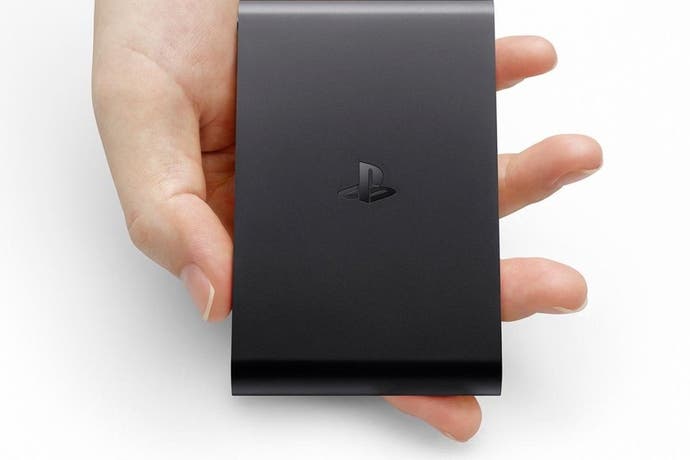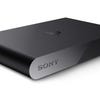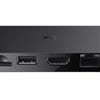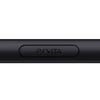PlayStation TV review
Over-priced and under-specced.
It's almost a year now since we first looked at Vita TV - the Japanese version of PlayStation TV, which finally launched in the UK a couple of days ago. Back then, we loved the idea of a credit-card sized Vita micro-console, but supporting services were thin on the ground, game support was lacklustre, and its flagship feature - PS4 Remote Play - wasn't yet implemented. A lot has changed since then, but there's still the sense that PlayStation TV has a rich vein of potential that Sony still hasn't managed to tap into.
Let's address the positives first. PlayStation TV remains a beautifully designed piece of kit - it looks great, it feels solid and well-built, and the plastics are of a decent quality. It's completely identical to the original Japanese model of course, only the UK unit is presented in matte black instead of white. Set-up is a doddle, and while the user interface (virtually unchanged from the handheld Vita) is obviously better-designed for touch, everything works just fine whether you're using a Dual Shock 3 or its snazzier PlayStation 4 successor.
Sony has increased the amount of mobile devices that can be attached to your PSN account, meaning that even if you already have two Vita handhelds registered, there's now room to add another. Annoyingly you're still limited to just one user per device, but on the plus side, memory cards from your handheld can be swapped at will into the PlayStation TV, without having to reformat the card and lose your data. In short, you don't need to buy another of Sony's over-priced proprietary cards if you already own a Vita, and thus games only need to be downloaded once. There's also no issue with save games working between both devices either.
- Order the PlayStation TV from Amazon with free shipping
Also impressive is the wealth of games that are now available. Accessing the PlayStation Store reveals a vast array of games for download - encompassing Vita, PSP, PSone, minis and PlayStation mobile titles. If you're a long-time PlayStation Plus subscriber (dutifully 'buying' your freebies each month), the chances are that you'll already have a robust selection of really good games, while any CrossBuy titles you may have purchased in the past now finally become playable if this is the first Vita product you've bought. While many of the minis, PSone and mobile titles are rather lacking, there's still the sense of a vibrant ecosystem with plenty of games to enjoy.
On top of that, PlayStation TV can access existing PS Vita carts, the difference now being that many more of them actually work. A great many titles - including Borderlands and Killzone Mercenary for example - have been patched to support PlayStation TV, while Sony has white-listed a lot of existing games that don't use the touchscreen, including Need for Speed: Most Wanted, so that they can function on the micro-console. However, there's still a big bunch of superb Vita titles that haven't been updated - Uncharted: Golden Abyss is a stand-out example, but even more annoying by its omission is the excellent WipEout 2048, which could easily be updated to support the micro-console but remains tantalisingly out of reach.
The effectiveness of running mobile games on a mammoth HDTV varies on a title-by-title basis. Titles that run at native resolution - such as Just Add Water's Gravity Crash Ultra - upscale first to the micro-console's 720p output, which is then upscaled again by your HDTV to its native resolution. The result is a bit blurry, but still looks good. By contrast, sub-native Vita titles like Need for Speed: Most Wanted look rather rough. Scaled up on an HDTV, the low resolution is shockingly obvious, as are the low quality textures. It's at this point that you realise that the small screen of the handheld Vita does a pretty good job of disguising the visual shortcomings of many of its games. And of course the original OLED Vita had the greatest handheld screen ever seen in the games market, which helped immensely too.
After a day spent revisiting our library of Vita titles, one thing becomes clear - this is micro-console gaming on a level that nothing else we've played can match. Killzone Mercenary is still the best mobile first-person shooter ever made, while Rayman Origins and Child of Light make a good fist of matching up to their PS4 equivalents. Meanwhile, Sony's drive to make Vita the perfect platform for mobile indie gaming pays massive dividends for PlayStation TV - titles like TxK, Spelunky, Hotline Miami, Luftrausers, Thomas Was Alone and both seasons of The Walking Dead are available, with the system also playing host to a simply stunning version of Fez that looks and plays beautifully on PlayStation TV. The Vita is based on now-outdated mobile technology, but the overall library and the level of polish on offer in the games here remains a world apart from all but the very best iOS and Android titles - and yes, the Vita edition of Minecraft works fine on PlayStation TV too.
Of course, there's also PlayStation 4 Remote Play support - a feature that Sony is pushing strongly for the micro-console. In theory, PlayStation TV can offer a lower-latency experience compared to the standard Vita, owing to the provision of wired LAN support built into the unit. We looked at this a few months back, and revisited it with the UK unit, and we remain fairly underwhelmed with this functionality owing to the noticeable lag and the need for a solid connection to your router. Even with a fully wired connection, it's still sub-optimal compared to local play, and the chances of you having a fully LANed up house are probably quite small. Meanwhile, WiFi connections can work OK - but only if you're relatively close to your router, and only if your PS4 is connected directly to it via a LAN cable. A normal/high video quality option has been added since we last looked at it, but otherwise the experience remains the same.
Another element that hasn't changed so much since we first looked at the Japanese Vita TV is the poor surrounding infrastructure. In a world where UK buyers can buy a NowTV streaming box for £10 and gain access to virtually every major catch-up TV service, the fact that none of them are available for PlayStation TV is a real disappointment. There's no support for Netflix or Amazon Prime Video either, though Sony has at least released a network media player, so you can access video and audio via a local DLNA server. (Sony told us that it is having conversations with "all the usual parties" and hopes to add support for more services, whether in native apps or via PS4 Remote Play.) Other than that, the only media services you have access to are Sony's own - and they're not very good. We had a quick look at some of the movies on offer and found only SD versions available, even with Sony's own movies, like The Amazing Spider-Man 2. Over-priced (£3.49 to rent, £9.99 to buy these SD encodes) and uncompetitive, it's hard to believe that Sony is taking its own media services seriously.
Without strong supporting services, what we're left with is essentially a Vita without a screen - but what really kills PlayStation TV's chances of success is its inflated price-point. It costs £85 for just the micro-console, HDMI cable, power adaptor and a redeem code for OlliOlli, Velocity Ultra and Worms Evolution Extreme. You aren't even supplied with a controller - you need to supply your own Dual Shock 3 or Dual Shock 4, otherwise you're left with a completely inoperable device. The question is, how much does PlayStation TV cost to make and just how can the price be justified? Let's put this way: you can buy a full Windows 8 tablet with a more advanced processor, touchscreen, and 32GB of storage and it's still £5 less than Sony's asking price for the PlayStation TV. In terms of pure build cost, PlayStation TV will obviously cost Sony far, far less to build yet the consumer is still being asked to pay a phenomenal premium. [UPDATE 16/11/14 6:21pm: Erroneous references to 'RAM' have been corrected to 'storage'.]
As it is, to get PlayStation TV running comfortably as a games machine, you're looking at spending over £35 on a controller (unless you're happy shuttling Dual Shocks around the house), and at least £20 on a decent-sized memory stick (the 1GB of onboard storage fills very, very quickly). Once you cross the £100 threshold, the case for PlayStation TV becomes very weak indeed - we're swiftly moving into second-hand Xbox 360 and PlayStation 3 territory.
All of which is a massive shame. Almost every element of the PlayStation TV comes across as under-baked, yet so rich in potential. There's genuine magic here in the form of an enviable software library, but it could be so much better still if more of the Vita's superb back-catalogue is patched to work on the micro-console. Meanwhile, there's absolutely no technological reason why PlayStation TV couldn't run Netflix or any of the other major streaming platforms and catch-up TV services. 11 months on from the Japanese launch, it's astonishing that Sony hasn't been able to get any major streaming service provider on board, though we're told that the firm is hoping to add support for more video services.
With more robust media support, improved game compatibility, a decent amount of onboard storage and the inclusion of an actual controller, a £70 PlayStation TV could be the ultimate all-in-one streaming micro-console, and PS4 Remote Play would be the icing on the cake as a decent value-added extra. As it is, the under-specced, overpriced launch product we have here is more of a tech curiosity as opposed to the must-have entry-level console it could have been.






